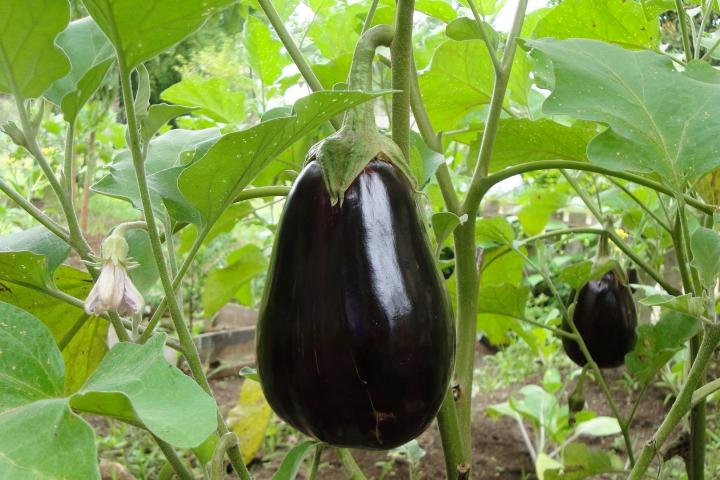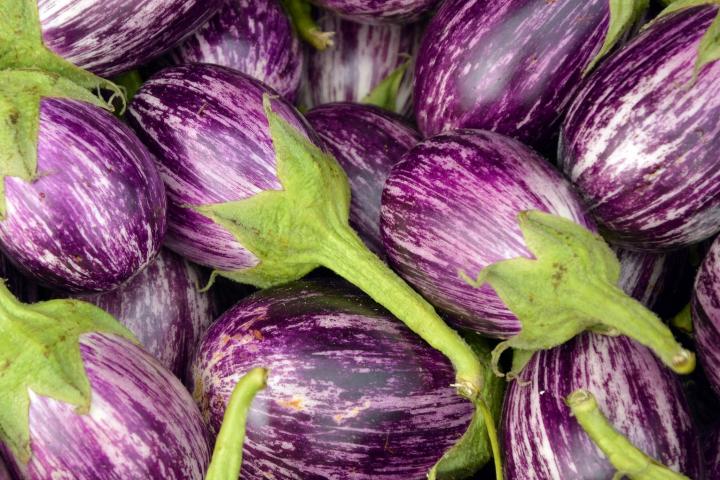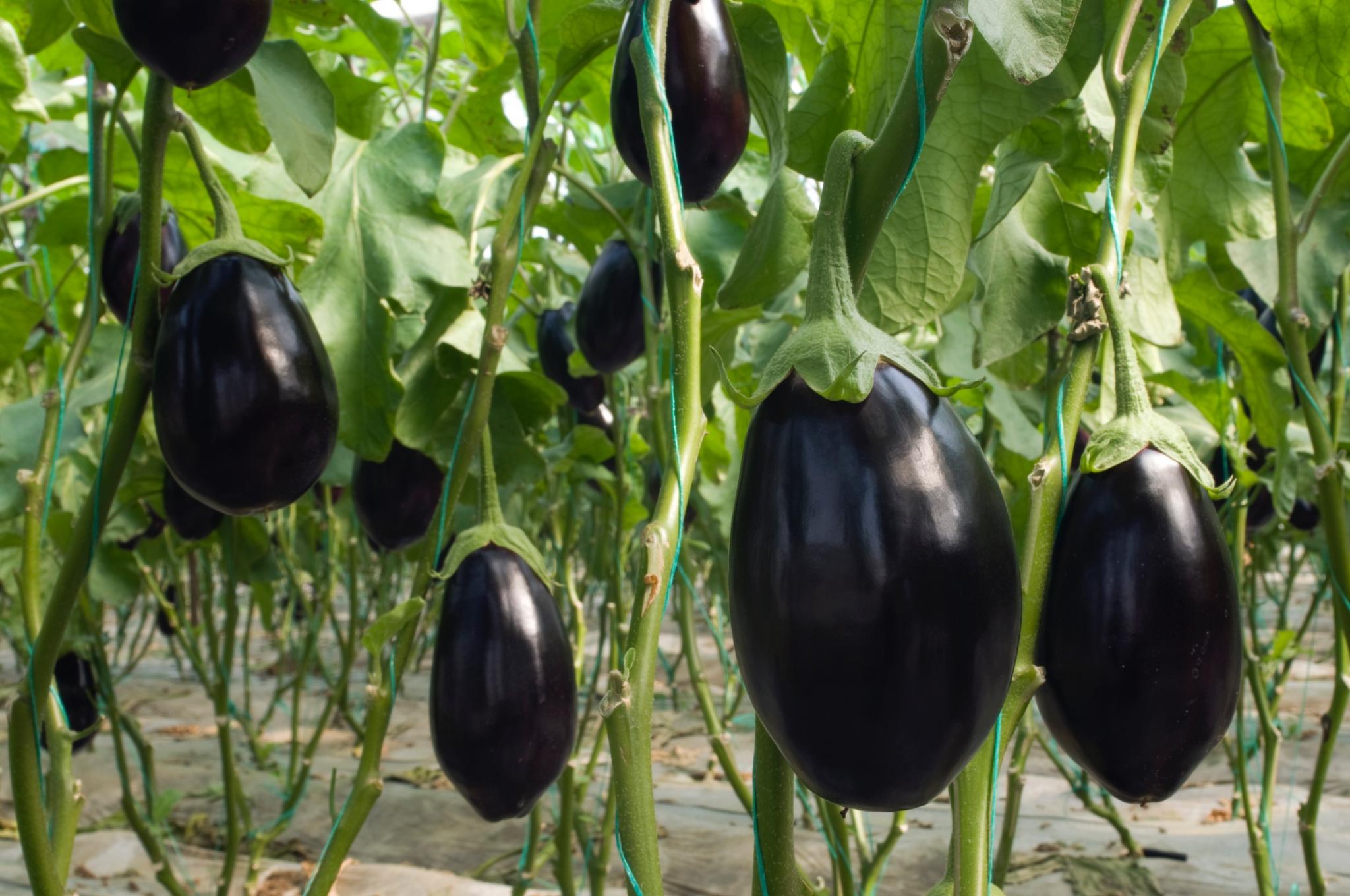Eggplants—also known as aubergines or brinjals—are warm-weather vegetables that are harvested in mid- to late summer. Eggplant tastes best when harvested young. See more about growing and harvesting these lovely deep purple vegetables—one of our favorites on the grill!
About Eggplants
Eggplants (Solanum melongena) grow wild in South Asia as a perennial plant, but these warm-season vegetables are treated by most North American gardeners as annuals. Given their tropical and subtropical heritage, eggplants do require relatively high temperatures, similar to tomatoes and peppers (which, like eggplants, are in the Nightshade family). They grow fastest when temperatures are between 70° and 85°F (21° and 30°C)—and very slowly during cooler weather.
Like tomatoes and peppers, eggplants develop and hang from the branches of a plant that can grow several feet in height.
Because they need warm soil, eggplants are usually purchased as 6- to 8-week-old transplants (or started indoors about two months in advance) to get a head start. Raised beds enriched with composted manure are an ideal growing place for eggplants because the soil warms more quickly. Eggplants are also great for containers and make lovely ornamental borders. In fact, there are quite a few ornamental eggplant varieties available today, whose inedible fruit have attractive variegated patterns.
Though eggplant fruits are usually a beautiful dark purple color, they can also be white, pink, green, black, or variegated purple-white. Their size and shape varies as well, ranging from the large, gourd-shaped eggplants you’ll commonly find in stores to the more exotic slender Japanese eggplant.
- Plant eggplant in a location that gets full sun—6 to 8 hours of direct sunlight per day—for the best results.
- Eggplant grows best in a well-drained sandy loam or loam soil that is fairly high in organic matter. To improve soil fertility, mix 1 inch of well-rotted manure, compost, or a general fertilizer such as 5-10-5 throughout the planting bed about a week before planting. (Apply 2 to 3 pounds per 100 square feet. Or, apply 1¼ pounds of 5-10-5 per 10 feet of row when the row spacing is 4 feet.)
- Soil pH should be between 5.8 and 6.5 for best growth.
Growing in Containers
-
Raised beds, which warm more quickly than ground soil, are ideal for growing eggplant.
- If you’re growing eggplant in pots, use a dark-colored container that will absorb more sunlight. Put one plant per 5-gallon (or larger) pot in full sun and outdoors so it can be pollinated. Use a premium potting mix to avoid disease.
When to Plant Eggplant
- Start seeds indoors in flats or peat pots 6 to 8 weeks prior to the last spring frost date. Seeds germinate quickly at temperatures between 70° to 90°F (21° to 32°C). Alternatively, buy 6- to 8-week-old nursery transplants just before planting.
- Do not plant eggplant transplants into the garden until after the last threat of frost.
- If purchasing transplants: Buy high-quality specimens. Do not purchase tall, spindly plants or young plants that already have blossoms (ideally, young plants should spend energy becoming established before they begin flowering).
How to Plant Eggplant
-
Start seeds indoors, sowing them ¼ of an inch deep in flats or peat pots.
-
After risk of the last spring frost has passed and daytime temperatures are 70° to 75°F (60° to 65°F at night), set seedlings in holes 24 to 30 inches apart in rows 3 feet apart. Use a covering of black plastic mulch to warm soils before setting out transplants if soil temperatures aren’t yet high enough.
- Immediately after planting (in ground or pot), set 24-inch-high stakes 1 to 2 inches from each plant or use cages to provide support and avoid disturbing the soil or roots later. Eggplant will fall over when laden with fruit.
- After planting, water well. Add a layer of mulch to retain moisture and suppress weeds.
- If you live in a cold climate, consider using row covers to keep the young eggplants warm and sheltered. Open the ends of the row covers on warm days so that bees may pollinate the eggplants’ flowers.

- Eggplant will fall over once loaded with fruit! Be sure to stake tall plants or use a cage to keep the plants upright. If growing eggplant in containers, stake the stems before the fruit forms.
- Water well to moisten the soil to a depth of at least 6 inches so the soil is moist but never soggy. Consistent watering is best, and a soaker hose or drip system at ground level is ideal.
- The critical period for moisture is during fruit set and fruit development. Strangely shaped eggplants result from inconsistent or inadequate watering.
- Mulching can help to provide uniform moisture, conserve water and reduce weeds.
- Apply a balanced fertilizer every 2 weeks or so.
- Note: Too much nitrogen may cause excessive vegetative growth. If you are using plastic mulch, apply fertilizer through drip irrigation, or apply fertilizer to the side of the row.
- For bigger fruits, restrict to five or six per plant, pinching off the extra flowers that develop.
- For a bushier plant, pinch out the terminal growing points, the central points on a plant from which new shoots and leaves grow. Look for the newest (and usually smallest) leaves at the center of the plant and pinch out the bud forming there.
-
Eggplants are susceptible to temperature fluctuations: Cool nights (below 55°F/13°C) or hot days (above 95°F/35°C) can cause lack of fruiting. Cover plants on cold nights and provide shade (e.g., a beach umbrella) on hot, sunny days. Cold also impairs ripening.
| Pest/Disease | Type | Symptoms | Control/Prevention |
|---|---|---|---|
| Blight (early) | Fungus |
Leaves, beginning with lower ones, develop dark, concentric spots, often with yellow outer ring, and eventually die; fruit/stems also may be affected |
Destroy infected plants; choose resistant varieties; maintain proper soil fertility; ensure good air circulation; avoid overhead watering; water in morning; disinfect tools; rotate crops |
| Blight (late) | Fungus |
Small, greenish gray, water-soaked spots on leaves that enlarge and turn brown, sometimes with yellow halo; white, fuzzy growth on leaf undersides; stems also affected; fruit rots |
Destroy infected plants; choose resistant varieties; ensure good air circulation; avoid overhead watering; remove plant debris; rotate crops |
| Blossom-end rot | Condition | Dark, water-soaked spots on blossom end of fruit (opposite stem) may enlarge and become sunken and leathery | Caused by lack of calcium in fruit, often due to roots failing to obtain sufficient water and/or nutrients.
Remove affected fruit; plant at proper soil temperature; water deeply and evenly; use mulch; maintain proper soil pH (around 6.5) and nutrient levels; avoid excessive nitrogen; provide good drainage; prevent root damage |
| Colorado potato beetles | Insect |
Yellow-orange eggs laid in clusters on leaf undersides; larvae and adults chew holes in foliage |
Handpick; use straw mulch; weed; use row covers; destroy crop residue; rotate crops |
|
Flea beetles |
Insect |
Numerous tiny holes in leaves, as if hit with birdshot |
Use row covers; mulch heavily; add native plants to invite beneficial insects |
| Powdery mildew | Fungus |
Typically, white spots on upper leaf surfaces expand to flour-like coating over entire leaves; foliage may yellow/die; distortion/stunting of leaves/flowers |
Destroy infected leaves or plants; choose resistant varieties; plant in full sun, if possible; ensure good air circulation; spray plants with 1 teaspoon baking soda dissolved in 1 quart water; destroy crop residue |
| Tomato hornworms | Insect |
Chewed leaves (initially toward top of plant); rapid defoliation; black/green excrement on plant; gouged fruit |
Handpick (leave larvae that have white, ricelike cocoons, which house braconid wasp parasites); till soil in fall and spring; weed; add native plants to invite beneficial insects; grow dill as a trap crop or basil or marigolds as repellents; spray Bacillus thuringiensis (Bt) |
| Whiteflies | Insect |
Sticky “honeydew” (excrement); sooty, black mold; yellow/silver areas on leaves; wilted/stunted plants; distortion; adults fly if disturbed; some species transmit viruses |
Remove infested leaves/plants; use handheld vacuum to remove pests; spray water on leaf undersides in morning/evening to knock off pests; monitor adults with yellow sticky traps; spray with insecticidal soap; invite beneficial insects and hummingbirds with native plants; weed; use reflective mulch |
Other Common Eggplant Problems
- Temperature:
- If the flowers on your eggplants form but then fall off, or if fruit does not develop, the most likely problem is that the temperatures are too cold.
- If the fruits are small and not growing, it’s also probably too cold. Eggplants like it hot! Daytime temperatures need to be 80° to 90°F and night time temperatures should not go below 60° to 65°F or their grow is very slow to stalled. Wait for warmer temperatures; you may have to replant, depending on the variety.
- Inconsistent watering: Strangely-shaped eggplant are the result of inconsistent watering or low moisture.
The standard eggplant produces egg-shaped, glossy, purple-black fruit.
- ‘Black Beauty’ is the traditional eggplant size. One plant produces 4 to 6 large rounded fruit. Other regular types include ‘Black Magic’, ‘Purple Rain’, and ‘Early Bird’.
- ‘Black Bell’: classic oval to round, 6-inch, purple/black fruit; disease-resistant
- ‘Dusky’: classic pear-shaped, 6- to 7-inch, glossy purple/black fruit; excellent flavor; disease-resistant
Other interesting eggplant varieties include:
- ‘Applegreen’: oval, 5- to 6-inch, tender, pale green fruit
- ‘Bambino’: oval, walnut-size, purple/black fruit; 1 1/2-foot-tall plants
- ‘Casper’: cylindrical, 6-inch, snow-white fruit; mushroom flavor
- ‘Cloud Nine’: teardrop-shaped, 7-inch, white fruit; disease-resistant
- ‘Kermit’: Thai type; round; 2-inch, green fruit with white-striped shoulder
- ‘Rosita’: pear-shaped, 6- to 8-inch, rose-pink fruit; sweet flavor
The long, slender Japanese eggplant has a thinner skin and more delicate flavor.
- ‘Ichiban’: 10- to 12-inch, slim, purple/black fruit; bears until frost. Expect a dozen or more fruit from one plant.
- ‘Little Fingers’: finger-sized purple/black fruit; good for containers. Small-fruited varieties tend to be especially heavy bearers.
Ornamental varieties are edible, but have poor eating quality.
- ‘Easter Egg’ is an ornamental eggplant, usually white in color. (Not edible.)

- Harvest eggplant 65 to 80 days after transplanting, depending on the variety. When starting from seed, expect 100 to 120 days to maturity. July, August, and September (even into October) are all harvest months for eggplant, depending on where you live and the variety you planted.
- Don’t wait too long to harvest! Eggplant tastes best when harvested young. Then, the plant’s energy will go into producing new fruit. If you harvest early and often, the plant will be quite prolific. Once ready, check on your eggplants every 2 to 3 days.
- The best way to gauge the time to harvest: Fruits are ripe when their skin doesn’t rebound to gentle pressure from your finger. Harvesting is a bit of an art; fruits can taste bitter if picked when underripe or overripe. The skin of the fruit should look glossy and unwrinkled and have a uniform color. If you cut the eggplant open, the seeds should be soft but formed. If the skin looks faded and the seeds inside are dark and hard, the fruit will taste bitter.
- Japanese eggplant may be ready to harvest when the size of a finger or hot dog.
- When harvesting, do not pull the fruit (it won’t come off). Cut the fruit off with a sharp knife (the stem is tough) close to the stem above the green cap (calyx) on the top, leaving about an inch of it attached. The calyx can be prickly, so gloves are helpful.
- You can cut these plants back like peppers if your season is long enough for a second crop.

How to Store Eggplant
- Eggplants can be stored for up to 2 weeks in humid conditions no lower than 50°F (10°C).
-
In the refrigerator, they will keep for several days.
- Do not wash or cut in advance to avoid damaging the skin, which will quickly perish if exposed.
- To avoid discoloring of eggplant after cutting open for cooking or grilling, use a marinade with salt, vinegar, and/or lemon juice.
- At one time, it was fashionable for women to use a black dye to stain their teeth a gun-metal gray. The dye probably came from the same dark purple eggplant we see in the marketplace today.
-
Use a stainless steel knife (not carbon steel) to cut eggplant, or the flesh will discolor.
-
Eggplant originally came in only small, white varieties. Hanging on the plants, the fruit looked like eggs—hence its name.
- Eggplant is excellent grilled, roasted, breaded, fried, or baked! The thinner varieties (‘Ichiban’) are more ideal for grilling and roasting and the traditional varieties (Black Beauty) are great breaded or fried; the round fruit is also good as a “boat” for stuffing.
- Use a stainless steel knife (not steel) to cut eggplant or it will discolor.
- If your eggplant is oversize, the skin may be too tough to eat. Peel before cooking or bake the eggplant and then scoop out the flesh. If you’re baking eggplant, first pierce the skin a few times to allow steam to escape.
- Many Italians will tenderize an eggplant so it’s less bitter. Slice, sprinkle with salt, and allow it to rest for about 30 minutes.




